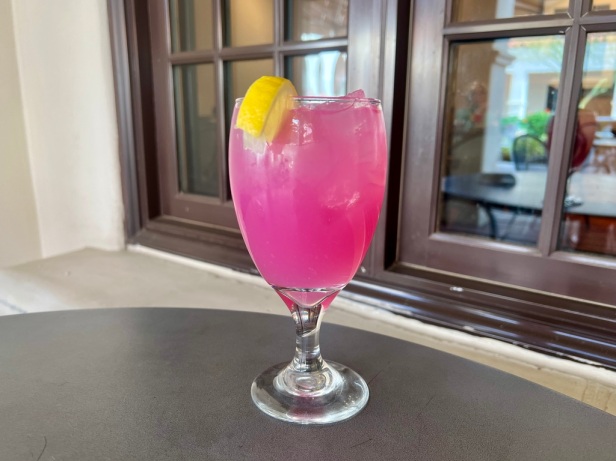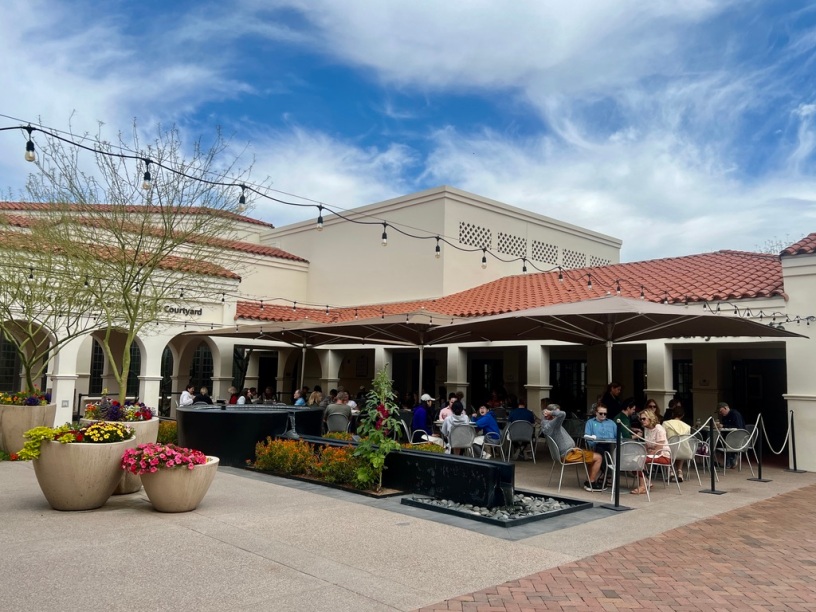Whenever a restaurant operates within a museum, there are two inevitable questions. The first is logistical: Does eating there require museum admission, or does the restaurant have its own separate entrance? The second, related question is if the food is good enough to make a visit just for a meal worthwhile, or does the place cater to a captive audience of museum attendees? When it comes to the Courtyard Cafe at the Heard Museum, the answer to both questions is “yes.” Museum admission is not required, and the restaurant is worthwhile on its own.

To be clear, the Heard Museum is a place that everyone should visit at least once for its permanent exhibits devoted to indigenous arts and the boarding school experience, temporary displays of works by noted artists like Maria Martinez and Allan Houser, and annual events like the World Championship Hoop Dance contest and the Indian Fair and Market. Nevertheless, the cafe’s separate entrance allows it to function as a restaurant in its own right, allowing it to stand on its own as Midtown lunch destination even when a museum visit is not planned.

The Heard Museum’s prominent location in Midtown is diagonally across the street from Encanto/Central station on the B Line. The Courtyard Cafe, as its name implies, is located in a central courtyard bounded by the main museum building, its extensive art shop, and its auditorium and educational building. A bike rack is found in the shade near the north end of the museum complex. The host stand for the Courtyard Cafe is found outside the restaurant, a logical choice since the majority of seating is outside in a well-shaded patio that dominates the courtyard.

There is a smaller interior dining room that is used more often during the hot summer months, but during peak times for tourism and museum visits, the outdoor seating is usually the preferred choice. Either way, the Courtyard Cafe operates as a full service restaurant rather than as a museum cafeteria. The menu focuses on Southwestern food with numerous Native American influences, as well as a few crowd-pleasing reminders of the Midwestern origins of Dwight and Maie Heard, the art collectors who founded the museum that bears their name.

A popular appetizer is the tepary bean hummus, a thick, nutty puree made with legumes indigenous to the region rather than the usual chickpeas. It’s hearty, particularly when served with triangles of fry bread, an adaptation of surplus ingredients given to forcibly relocated native populations that has become a state fair staple. The combination of hummus and fry bread makes this dish a meal in itself unless shared by an entire table. In terms of shareable starters that lend themselves to dipping, guacamole and shrimp ceviche are offered with tortilla chips.

Soups vary with the seasons. A recent sopa de lima, a light chicken soup with rice and a tart citrus note has recently been replaced with a cold three sisters blend of key ingredients in regional indigenous food traditions: corn, beans, and squash. Throughout the year, pozole is offered in a standard red version of the classic dish. It’s mild, perhaps as a concession to visitors unfamiliar with Southwestern cuisine, but still flavorful. It comes with shredded cabbage and tortilla chips, but a request for hot sauce to boost the heat level may be necessary.

The entree-sized salads also have a regional touch. The Dreamcatcher is a variant of the ubiquitous chopped salad with a spectrum of ingredients presented separately and waiting to be mixed together. Tomato, avocado, corn, dried cranberries, wheat berries, and pepitas are presented with mixed greens and a balsamic dressing. The Spanish Market salad incorporates black beans, roasted corn, tomatoes, avocado, jicama, cheddar cheese, and tortilla strips over crisp romaine with a chipotle ranch dressing. Cobbs and Caesar salads are also available.

In terms of Southwestern entrees, the birria tacos contain tender beef with abundant cabbage, crema, onions, and cilantro. There is red salsa and consomme, as well as small salad, on the side, rendering this a lighter approach than the cheesy, gooey quesabirra. The Four Peaks quesadilla is named not for the popular beer brand, but instead for its presentation. The cheese-filled tortilla is sliced into quarters and arranged to look like the Mazatzal mountains. The quesadilla can be augmented with shrimp, chicken, or roasted red peppers and onions.

Those same roasted vegetables appear once again in the garden grilled cheese, where they are complemented by spinach and mushrooms. The cheese melds with the bread, seeping out of the edges to acquire its own crispness on the griddle. A bit of coarse mustard adds an extra boost of flavor. A chicken salad sandwich on nine-grain bread benefits from the presence of tarragon, and a turkey and brie combination on cranberry walnut bread is enhanced by the presence of sliced green apples. All sandwiches come with a choice of chips or a side salad.

For dessert, the same fry bread offered up front with hummus can be served with ice cream, and there are also brownies and cookies to choose from. The restaurant has a small bar menu with beer, wine, and few cocktails. Among the choices without alcohol, the prickly pear lemonade stands out with its vibrant color and tart taste. With its continuously updated exhibits, the Heard Museum should be considered an essential experience for anyone who lives in or visits Phoenix. With the Courtyard Cafe, it’s possible to go for the art but stay for the food.
2301 N. Central Ave., Phoenix AZ 85004
https://heard.org/dining

